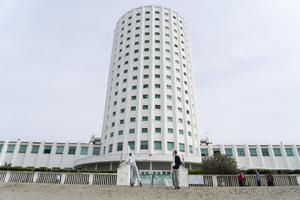Ausschnitt Videoversion TOWER POWER
Parent sets (1)Show all relations
The selected media entry was added to these sets.
1 Items
- Page 1 of 1
TOWER POWER
- Title
- TOWER POWER
- Author
- Description (de)
- TOWER POWER ist ein szenischer Kurzessay zur architektonischen Formensprache und Symbolik des Torre Fiat in Marina di Massa, Italien - einem Turm aus der Zeit des italienischen Faschismus und Ausstellungsort des POST-COLONIA Festivals of Architecture and Imaginaries in Transition, für das die Arbeit entwickelt wurde.
Als in Architektur materialisierte Ideologie steht der Turm scheinbar unausweichlich für eine lineare, gewaltvolle Erzählung von Geschichte. Mithilfe von Ursula K. Le Guins „Carrier Bag Theory of Fiction“ (1986) befragt TOWER POWER die dem Turm eingeschriebenen Narrative und den Umgang mit einem derart aufgeladenen baulichen Erbe:
"Are we in an airplane? A column? A ‚fascio littorio‘? What would each scenario mean? […] It’s just a building, right?" (deutsche Übersetzung: "Sitzen wir in einem Flugzeug? Einer Säule? Einem „Fascio Littorio“? Was würde das jeweils bedeuten? […] Es ist doch nur ein Gebäude, oder?")
- TOWER POWER ist ein szenischer Kurzessay zur architektonischen Formensprache und Symbolik des Torre Fiat in Marina di Massa, Italien - einem Turm aus der Zeit des italienischen Faschismus und Ausstellungsort des POST-COLONIA Festivals of Architecture and Imaginaries in Transition, für das die Arbeit entwickelt wurde.
- Description (en)
- TOWER POWER is a short performative essay, investigating the formal language and architectural symbolism of the Torre Fiat in Marina di Massa, Italy - a tower built during the Italian Fascist era, and the venue of POST-COLONIA Festival of Architecture and Imaginaries in Transition we had been invited to explore and exhibit in.
Steeped in ideology, the tower’s architecture inescapably seems to stand for a linear, violent historiography. TOWER POWER investigates the narratives inscribed into the tower through the lens of Ursula K. Le Guin’s Carrier Bag Theory of Fiction and poses questions on how to deal with such a charged architectural legacy:
"Are we in an airplane? A column? A ‚fascio littorio‘? What would each scenario mean? […] It’s just a building, right?"
- TOWER POWER is a short performative essay, investigating the formal language and architectural symbolism of the Torre Fiat in Marina di Massa, Italy - a tower built during the Italian Fascist era, and the venue of POST-COLONIA Festival of Architecture and Imaginaries in Transition we had been invited to explore and exhibit in.
- Category
- Type of project / creative work
- Keywords
- Date
- 2025
- Contributors
- Thanks to
- Language
- Title
- TOWER POWER
- Projektleiter/in
- Semester
- Program of Study
- Imported on
- 27.06.2025
- Parent sets
- 1
- Set is related to
- 0 8
